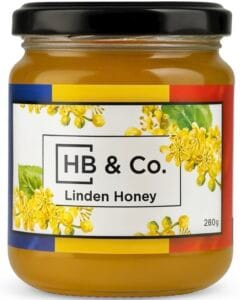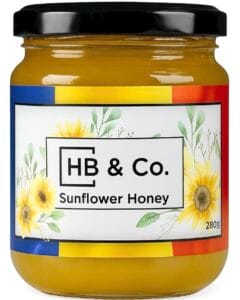Romanian Honey
Our Romanian Honey
Romanian Honey Heritage
Discover the Rich Flavours of Romanian Honey
Romanian Honey is not only a food; it is an inheritance. Across valleys and mountain passes, families still wake before sunrise to check hives, load them onto trailers, and follow the blossom. Spring acacia, early summer linden, late summer sunflower. The rhythm is patient and exacting, and it produces some of the most distinctive jars of organic honey you can put on your table.
This is the story behind the jars we curate at HoneyBee & Co. : Romanian Honey shaped by landscapes, seasons and people who keep bees the way their grandparents did.
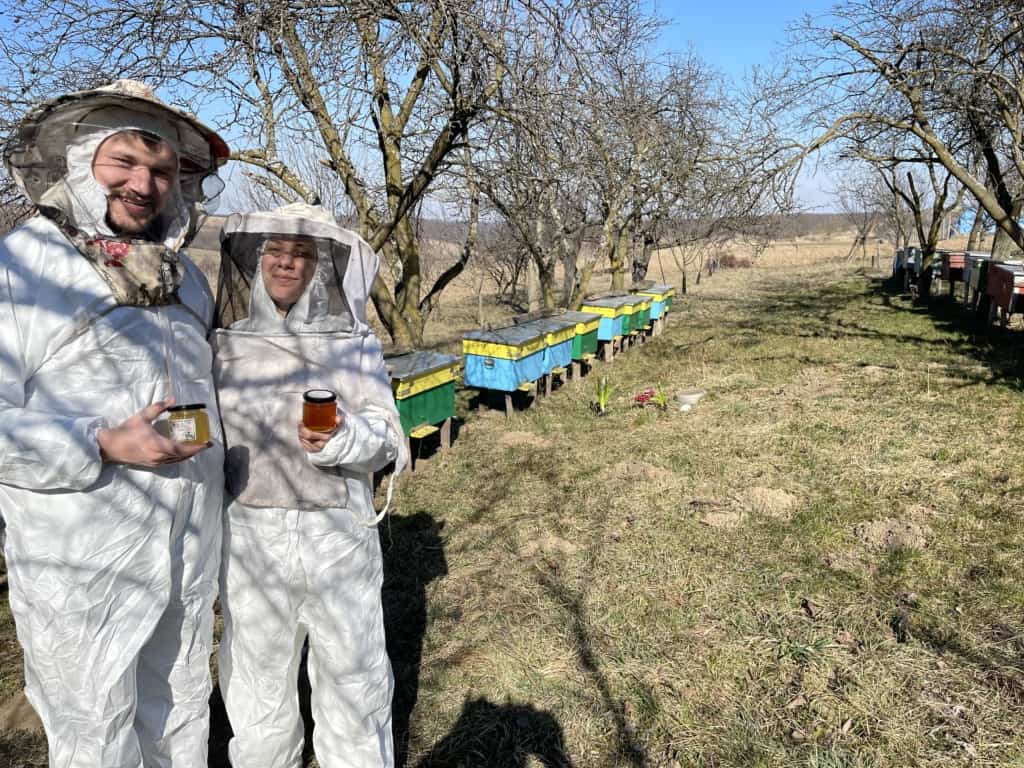
Romania’s natural canvas is made for bees
Few countries pack so much diversity into a single map. The Carpathians weave through the centre with high meadows and forest honeydew sources. The Danube fans into a vast delta of reeds and willows. Plains to the south and east offer broad belts of acacia and sunflower, while rolling hills hold old orchards and hay meadows rich in clover, sainfoin and wild flowers that many parts of Europe have lost. Large Natura 2000 reserves and national parks add another layer of protection, so nectar sources are plentiful and relatively clean.
The result is range. Romanian Honey can be delicate and water-pale or deep amber with a resinous edge. It can be almost syrupy or quick to crystallise into a creamy spread. It can carry vanilla, mint, citrus-zest or warm hay. All from a single country.
A living family heritage
Romanian beekeeping is often a family calling. In villages that sit beside linden forests or on the road to the plains, the apiary sits behind the house, and the knowledge sits at the kitchen table. Grandparents remember wintering hives in the woods, then moving them in spring to the acacia stands, then to sunflower later on. Children learned by watching, lifting, listening for the hum that tells you all is well.
This seasonal movement has a purpose. Bees meet each major bloom at its peak, staying healthy and productive while keeping flavours clean. Families tend to keep the native Carpathian bee, known for its calm temperament and thrift in cool springs, and they favour wooden hives and natural wax. Many still participate in local festivals and blessings tied to the honey calendar. It is practical work, and it is cultural memory.
When you taste Romanian Honey, you are tasting a way of working that prizes steadiness, care and respect for place.
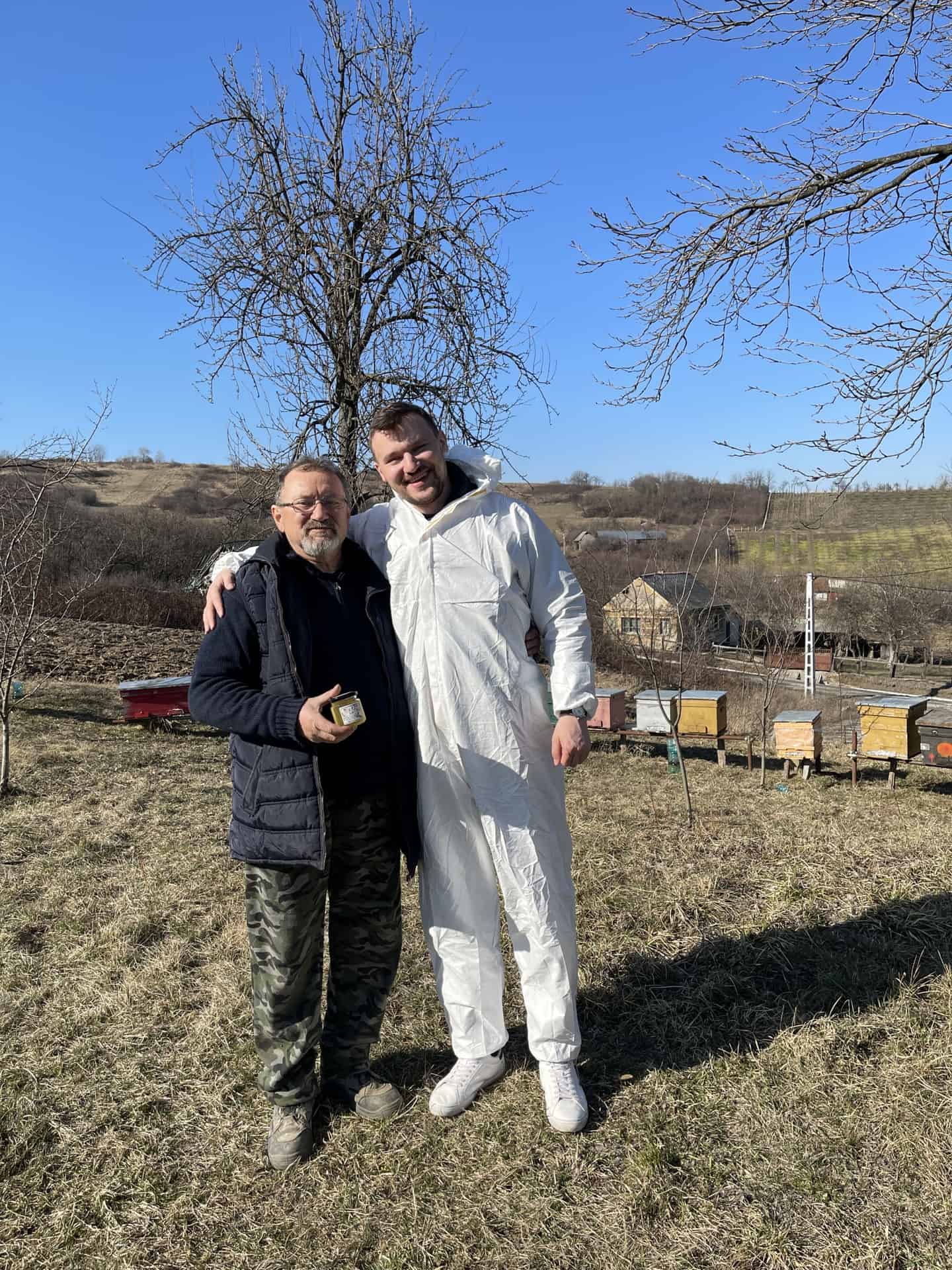
Romanian Acacia Honey: crystal clarity and gentle sweetness
Acacia honey from Romania is famous for a reason. It looks almost water-white, often with a faint straw hue. Lift the jar and watch the liquid run in long ribbons. That flow tells you something about its chemistry: very high fructose relative to glucose, very low acidity, very slow to crystallise. The flavour is delicate, floral and sweet with hints of vanilla and soft fruit. There is little aftertaste, which makes it incredibly versatile.
- Colour: almost clear to very pale gold
- Aroma: floral and perfume-like, occasionally vanilla-toned
- Taste: mellow and clean, with an elegant sweetness
- Texture: fluid for months at room temperature
- Crystallisation: very slow
Pair it with fine teas, Greek yogurt, fresh strawberries, ricotta on toast, or a washed-rind cheese where you need satin-smooth sweetness to balance salt. In pastry work, it keeps batters moist without dominating. In cocktails, it sweetens without clouding your profile.
Weather shapes it. Warm, steady springs give abundant nectar and a looser, silken flow. Cold snaps can lend a faint haze or quicker grain. Either way, properly handled acacia from Romania remains one of the gentlest honeys you can buy.

Romanian Linden Honey: aromatic brightness with herbal lift
Linden, or lime tree honey, sits at the other end of the flavour map. Open a jar and you get blossom fragrance with a whisper of menthol or citrus peel. On the palate it is sweet yet lively, sometimes with an herbal or slightly bitter finish that keeps it refreshing. That character comes from the tree’s volatile oils and terpenes, which ride into the honey and give it a cooling edge.
- Colour: light amber to pale yellow, darkening if honeydew is present
- Aroma: blossom-forward with minty or citrus-herbal notes
- Taste: bright, floral and lightly spicy, often with a gentle bitter tail
- Texture: medium viscosity; can set into larger crystals over time
- Crystallisation: moderate to fast
Linden honey sings with hot buttered toast, blue cheeses, grilled peaches, or a lemony vinaigrette for bitter leaves. Stir it into chamomile tea for a layered floral cup. Bakers use it to lift ginger biscuits and fruit cakes. When a recipe needs both sweetness and a nudge of complexity, this is the jar you reach for.
The best linden comes from regions with extensive lime forests and cool nights in July. In some years you will notice a deeper colour and resinous tone if bees also tapped forest honeydew during hot spells.
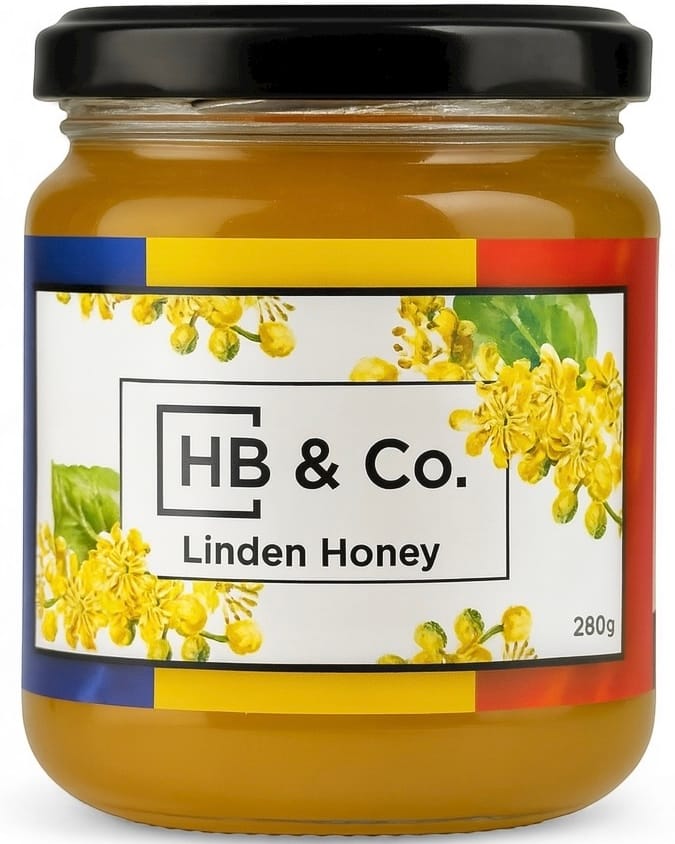
Romanian Sunflower Honey: golden, creamy and cheerful
Sunflower honey catches the eye first. It is bright and golden, with a sunny aroma that recalls fields in late August. The flavour is mild, honeyed and creamy, sometimes with subtle nutty or herbal hints. It is often more mineral and slightly brisk on the palate compared to acacia, which gives it a pleasing, rounded feel.
- Colour: bright golden yellow
- Aroma: floral and warm, a classic honey scent
- Taste: pleasant sweetness with faint nutty or herb tones
- Texture: smooth when fresh, then a fine-grained cream as it sets
- Crystallisation: fast
This is the breakfast honey, perfect for adding a touch of nutrition to your morning meal. Spread it on crumpets, swirl it into porridge, glaze roast carrots, or whisk it into a mustard dressing for roast chicken. When it crystallises, it takes on a spoonable creaminess that children love. If you prefer it runny, stand the jar in barely warm water and it will loosen without losing flavour.
Regional soils and summer heat influence organic honey, particularly sunflower honey. Hot, dry summers bring strong aroma and deeper amber; cooler, wetter periods yield paler, gentler batches. Either way, it is dependable and friendly.
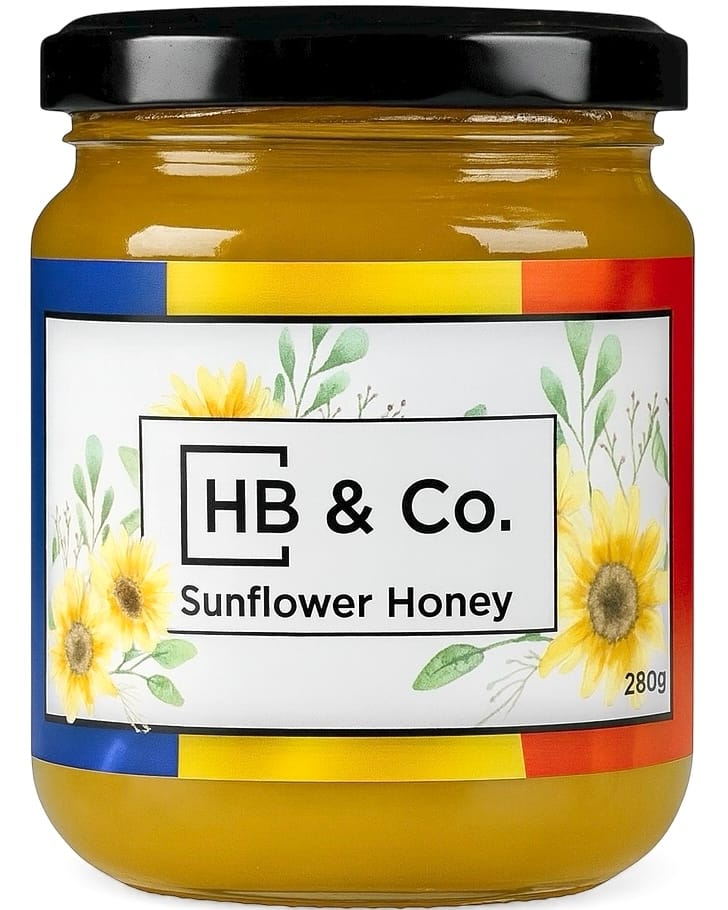
Quick guide to flavour and texture
| Variety | Colour | Aroma and flavour profile | Texture and crystallisation | Kitchen notes |
|---|---|---|---|---|
| Romanian Acacia Honey | Water-white to pale straw | Very floral, soft vanilla, clean and gentle | Very fluid, crystallises very slowly | Tea, yogurt, light cheeses, patisserie, cocktails |
| Romanian Linden Honey | Pale yellow to light amber | Blossom-forward, minty-citrus, lightly herbal/spicy | Medium body, sets moderately fast | Blue cheese, grilled fruit, biscuits, vinaigrettes |
| Romanian Sunflower Honey | Bright golden yellow | Mild, creamy sweetness, subtle nutty/herbal tones | Smooth then fine-grained cream fast | Breakfast spreads, roasting glazes, dressings, bakes |
Season, soil and altitude: why Romanian Honey varies so beautifully
Two jars labelled the same can still show nuance. The reasons are simple and fascinating.
- Season: A wet spring can dilute acacia nectar and nudge the sugar balance, which may quicken crystallisation. A hot July can push linden toward deeper colour and a firmer herbal finish. Drought concentrates sugars and can intensify aroma.
- Altitude: Higher, cooler apiaries produce lighter, more aromatic honeys. Lowland plains often give richer colour and a deeper, rounder taste.
- Soils and flora: Sunflower belts in the south and east give consistent, cheerful honeys. Mixed forests in Transylvania can add a touch of honeydew to linden, shading colour and taste. Old hay meadows gift polyfloral jars with clover, sainfoin and mint notes.
This is terroir in the clearest sense. Bees translate landscape into flavour.
How we source at HoneyBee & Co.
The Sunflower, Acacia and Linden Honeys are produced by our loving family in Romania but we also work with small and mid-sized family apiaries we have visited. We favour the native Carpathian bee and keep to regions where acacia and linden grow in abundance, with sunflower belts within a day’s move.
A few commitments guide every jar we bring in.
- Single-origin batches with full traceability by region and harvest date
- Raw and unheated, filtered only to remove wax and hive fragments
- Independent analysis for moisture, HMF, diastase and pollen profile
- Respect for bee health: no antibiotics, careful winter feeding, clean combs
- Fair relationships that recognise the craft behind each harvest
We publish batch notes on flavour and texture, plus a best-use guide for each variety. If a linden run picked up a whisper of forest honeydew, you will see that on the card. If an acacia is crystal-clear and extra viscous after a warm spring, we will say so.
Serving and pairing ideas
Make the most of Romanian Honey and organic honey with a few simple ideas, while also considering the nutritional benefits they bring.
- Romanian Acacia Honey
- Drizzle over fresh figs with mascarpone and almond flakes
- Dress a melon and mint salad with a teaspoon of acacia and lime juice
- Shake with gin, lemon and a touch of salt for an elegant sour
- Romanian Linden Honey
- Glaze baked pears and serve with blue cheese and walnuts
- Stir into a hot tisane of lemon verbena or chamomile tea
- Whisk into mustard, cider vinegar and olive oil for a leaf-and-herb salad
- Romanian Sunflower Honey
- Spread on warm sourdough with salted butter
- Toss with carrots or parsnips before roasting, then finish with thyme
- Use in overnight oats with apricots and toasted seeds
Storage tips help too. Keep jars at room temperature away from bright light. If sunflower or linden set hard, stand the jar in a bowl of warm water for a few minutes and stir gently. Do not microwave, which can damage aroma and enzymes. Acacia prefers a cool cupboard to stay limpid for longer.
Choosing the right Romanian Honey for your shelf
If you like your honey light and neutral, Romanian Acacia Honey is the classic. It sweetens without getting in the way, and it stays runny for months. If you want scent and a touch of herbal lift, go for Romanian Linden Honey. You will taste blossom with a minty thread and a crisp finish that holds up in cheese pairings and baking. If you prefer a friendly, everyday spread with a pleasing creaminess, Romanian Sunflower Honey will suit you nicely.
A few pointers when you buy:
- Look for monofloral labelling where the pollen analysis and taste match the name
- Expect natural crystallisation in linden and sunflower; it is a sign of quality, not a flaw
- Seek clear batch and region details; the best producers are proud of place
- Consider a tasting trio to appreciate how acacia, linden and sunflower differ across the same harvest year
At HoneyBee & Co we offer all three, available as single jars or in curated sets with tasting notes.
Romania’s beekeeping ethos shines through the jar
Stand in a linden grove on a still July evening and you feel it: that soft perfume that hangs in the air. Watch hives lined up at the edge of a sunflower field after dawn, bees lifting like smoke above the heads of beekeepers who have done this work since they were children. Later, in a Transylvanian village, a fair opens with brass bands and samples of comb passed from hand to hand.
Romanian Honey carries these scenes. It carries the hush of forests where bees gather honeydew, the crackle of dry grass in a hot August field, the careful hands of families who move with the flowers. It is generous in flavour and honest in character.
If you have only ever bought generic blends, try the clarity of Romanian Acacia Honey, the aromatic lift of Romanian Linden Honey, the multifaceted richness of polyfloral honey, and the golden cream of Romanian Sunflower Honey. Taste them side by side. Let them tell you where they come from.
And if you would like help choosing, our team at HoneyBee & Co is ready with current batch notes and pairing suggestions. We hope your next spoonful brings you a little closer to Romania’s fields and forests, and to the people who keep them sweet.
Your Questions Answered
The Hive
Interesting news, commentary, lifestyle, and all things Bees - have you got the buzz?

